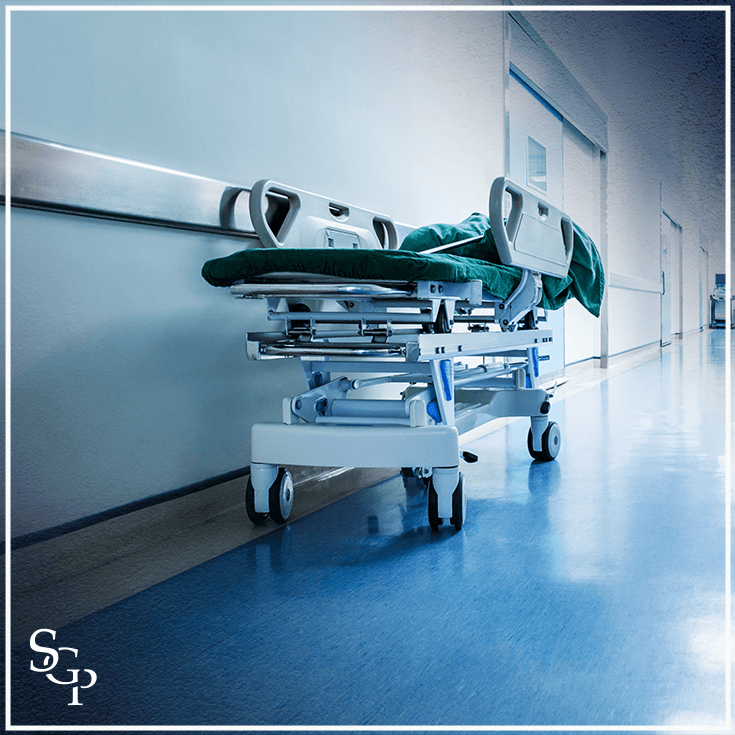

New York Medical Malpractice Lawyers
How We Can Help Your Medical Malpractice Claim in NYC
The New York medical malpractice lawyers at Simonson Goodman Platzer PC have been representing victims of medical malpractice for decades. Our firm has recovered more than 200 million dollars for our clients, proving successful in securing compensation in 98% of the cases handled.
One of our partners, Attorney Paul Simonson, has been named Lawyer of the Year for Plantiffs Medical Malpractice. Paul, along with our other attorneys, has consistently been recognized for his legal practice, including being named as a “Best Lawyer in America” and selected for inclusion in the Super Lawyers® list in the field of medical malpractice.
At Simonson Goodman Platzer PC, we have a long history of success in representing victims of all types of medical negligence. Call (800) 817-5029 today to get started with a free consultation. You can also email us 24/7.


What is Considered Medical Malpractice?
Medical malpractice is a legal term used to describe a situation in which a healthcare provider, such as a doctor, nurse, surgeon, or hospital, fails to provide an appropriate standard of care to a patient, resulting in harm or injury to the patient. This negligence or breach of duty can occur in various healthcare settings, including hospitals, clinics, and private practices.
Key elements of medical malpractice typically include:
- Duty of Care: Healthcare providers have a legal and ethical responsibility to provide their patients with a standard of care that is in line with accepted medical practices.
- Breach of Duty: A breach occurs when the healthcare provider deviates from the expected standard of care. This can involve errors in diagnosis, treatment, surgical procedures, prescription medication, or a failure to provide adequate information to the patient.
- Causation: The breach of duty must be shown to be the cause of the patient's injury or harm. It must be demonstrated that the healthcare provider's actions or negligence directly led to the negative outcome.
- Damages: In order to pursue a medical malpractice claim, the patient must have suffered some form of harm or injury. These damages can include physical, emotional, and financial losses, such as pain and suffering, medical bills, loss of income, and long-term disability.
Medical providers are highly trained professionals with years of schooling and training. However, that does not mean that they are always able to achieve the outcomes patients want. A poor outcome after a medical procedure or treatment does not necessarily mean that the patient is a victim of malpractice. Instead, medical malpractice occurs when a doctor or another health care provider fails to provide services that meet the accepted standard of care.
Examples of Medical Malpractice
Medical malpractice cases can encompass a wide range of situations in which healthcare providers fail to meet the standard of care, resulting in harm or injury to patients. Some common types of medical malpractice cases include:
- Misdiagnosis or Delayed Diagnosis: This occurs when a healthcare provider fails to correctly diagnose a medical condition or there is a significant delay in diagnosing a condition, leading to incorrect treatment or missed opportunities for timely intervention. Common examples include misdiagnosis of cancer, heart disease, or infections.
- Surgical Errors: Surgical malpractice can involve a variety of mistakes made during surgery, such as operating on the wrong body part, leaving surgical instruments or sponges inside the patient, damaging adjacent structures, or improper suturing. Any of these errors can lead to serious complications.
- Medication Errors: Medication-related malpractice can include prescribing the wrong medication, administering the incorrect dosage, overlooking drug allergies or interactions, or failing to provide clear medication instructions to the patient. These errors can lead to adverse reactions and worsen a patient's condition.
- Anesthesia Errors: Anesthesia-related mistakes can include administering too much or too little anesthesia, failing to monitor a patient's vital signs during surgery, or not considering the patient's medical history and allergies. Anesthesia errors can result in complications, including injury or death.
- Birth Injuries: These cases involve injuries to the baby or mother during childbirth due to medical negligence. Common examples include the misuse of forceps or vacuum extractors, delays in performing a cesarean section, or failure to monitor fetal distress.
- Emergency Room Errors: Errors in the emergency room can involve misdiagnosis, delays in treatment, or inadequate patient triage, which can have serious consequences for patients who require immediate care.
- Informed Consent Violations: Failure to obtain proper informed consent occurs when healthcare providers do not adequately inform patients about the risks, benefits, and alternatives of a medical procedure or treatment. This can result in legal claims if patients undergo procedures without full understanding.
- Lack of Follow-Up Care: Healthcare providers have a responsibility to monitor patients' conditions and ensure they receive appropriate follow-up care. Neglecting this duty can result in complications or deterioration of the patient's health.
- Hospital-Acquired Infections: Healthcare-associated infections (HAIs) can occur when patients contract infections while receiving treatment in healthcare facilities. These infections may result from improper sterilization of medical equipment, inadequate hand hygiene practices, or failure to implement proper infection control protocols.
- Nursing Home Neglect: Nursing home staff have a duty to provide adequate care to residents, including assistance with daily activities, proper medication management, and ensuring a safe environment. Neglect in nursing homes can lead to serious injuries such as falls, bedsores (pressure ulcers), malnutrition, dehydration, or untreated medical conditions.
- Radiology Errors: Radiology errors can occur when radiologists misinterpret imaging studies such as X-rays, MRIs, or CT scans, leading to delayed or incorrect diagnoses. For example, failing to detect a tumor or misinterpreting a fracture could result in delayed treatment or unnecessary procedures.
- Failure to Provide Emergency Care: In emergency situations, healthcare providers have a duty to provide prompt and appropriate care to stabilize patients and prevent further harm. Failure to provide timely emergency care, such as delaying treatment in the emergency room or misdiagnosing a life-threatening condition, can result in serious injury or death.
Who is Liable for Medical Malpractice?
Medical malpractice occurs when a healthcare professional or institution fails to provide a standard level of care, resulting in harm to a patient. Liability for medical malpractice can extend to various parties involved in the provision of healthcare. Here's a breakdown:
- Medical Professionals: Doctors, surgeons, nurses, anesthesiologists, dentists, and other healthcare professionals can be held liable if their actions or negligence directly cause harm to a patient.
- Healthcare Institutions: Hospitals, clinics, nursing homes, and medical facilities can be held liable for medical malpractice if they fail to uphold proper standards of care, such as inadequate staffing, lack of proper protocols, or faulty equipment.
- Pharmaceutical Companies: If a medication or medical device manufactured by a pharmaceutical company causes harm due to defects or inadequate warnings, the company may be held liable for medical malpractice.
- Third Parties: Sometimes, individuals or entities not directly involved in patient care may be liable for medical malpractice. For example, if a medical equipment supplier provides faulty equipment that leads to patient harm, they may be held responsible.
- Government Agencies: In cases where healthcare is provided by government agencies or facilities, such as public hospitals or clinics, the government may bear liability for medical malpractice.
- Joint Liability: In some cases, multiple parties may share liability for medical malpractice. For instance, if a surgeon makes an error during a procedure in a hospital, both the surgeon and the hospital may be held jointly liable.


Client Testimonials
Hear What Our Clients Have to Say
-
"Accommodating and Professional"The attorneys were kind, accommodating and professional. I couldn’t be happier with the settlement they achieved for me.Inbar V.
-
"Totally Changed My Life"They have done an amazing job to win my case without even going to the court.Sezgin T.
-
"Highly Recommend"Highly recommend!! I had the pleasure of working with Paul Simonson during the worst time of my life. He is knowledgeable, professional & he truly cares. When other attorneys turned down my case Mr. Simonson got results! I will be forever grateful.Dawn M.
-
"I would highly recommend this firm."I would highly recommend this firm. Ted knows the law and did a great job.Dana
-
"I Felt Comfortable and Supported"They were honest and clear about the process of bringing a lawsuit forward and managed my expectations.Nate G.
-
"I Highly Recommend This Law Firm"Thank you, Mr. Goodman and Mr. Simonson very much for looking out for me and always having my best interest at heart!Naresh T.
-
"The gratitude I feel towards them is immeasurable."Based on my experience with this firm, their name should be empathy, compassion and brilliance. Their kindness and attention to detail was second to none. I truly cannot say enough good things about Paul, Ted and this firm. The gratitude I feel towards them is immeasurable.Nic R.
-
"There are no amount of words that can show how grateful I am for all they have done."Ted Goodman was amazing in the courtroom and eloquently argued my case. If I could give them 10 stars I would, they truly changed my life. There are no amount of words that can show how grateful I am for all they have done.Ashley W.
Proving a Medical Malpractice Case in New York
Proving your medical malpractice case can be extremely difficult, if not impossible, without the help of an experienced med mal attorney in New York City. At Simonson Goodman Platzer PC, our experienced New York medical malpractice lawyers can help you determine if you have grounds for a case and, if so, will begin immediately investigating your situation and working with medical experts to demonstrate how a medical provider deviated from the standard of care and what effect this has had on your life.
What is the Accepted "Standard of Care?"
In order to prove that there was a deviation or departure from the accepted standard of care, the patient must first establish the existence of a specific standard of care to be applied to the particular circumstance. Next, the patient must prove that the standard was violated.

What Damages Can You Recover in Medical Malpractice Cases?
Patients may recover monetary damages for both physical and emotional losses in medical malpractice cases.
Though every case is different, if you are the victim of medical malpractice, you may be entitled to compensation for the following damages:
- Medical costs associated with additional treatments, including revision surgeries
- Other medical expenses, such as rehabilitative treatment
- Medications, medical devices, and medical equipment (wheelchairs, etc.)
- In-home care costs and costs associated with home modifications
- Lost wages, including lost future earnings
- Loss of enjoyment of life
- Pain and suffering, including emotional distress and trauma
- Wrongful death damages
In addition to pain and suffering, emotional distress, and hedonic damages, suits are permitted for damages that occur as the result of “wrongful” death. In order to bring such a suit, an executor or administrator must be appointed by the court.
-
$1.8 Million $1,800,000 (Partial) Settlement (Kings County)
A 29-year-old married resident of Manhattan presents to the ER for various complaints. A CT scan is performed and shows a suspicious lesion in the kidney, but the hospital fails to advise the patient of the same and fails to send the CT scan report to the patient’s primary care doctor.
-
$1.9 Million $1,975,000 Gastric Bypass Malpractice Settlement
-
$1.7 Million $1.7 Million Jury Verdict
-
$2 Million $2,000,000 Settlement (Middlesex County, NJ)
$2,000,000 settlement for a young 29-year-old New Jersey wife and mother who developed bleeding after giving birth to a stillborn.
-
$4.5 Million $4.5 Million Dollar Settlement
